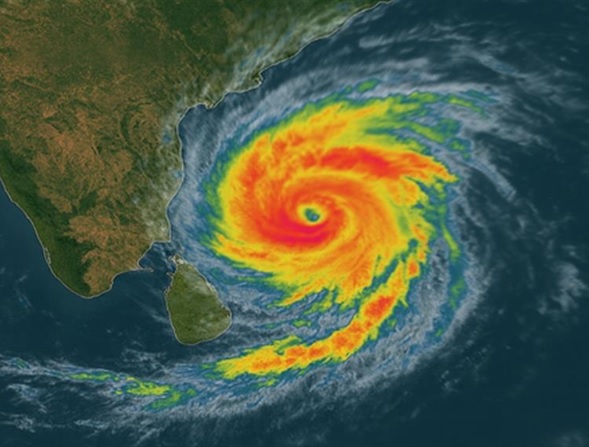| Mains GS Paper 3-disaster management |
India’s approximately 7,500 km long coastline makes it highly vulnerable to tropical cyclones. On average, 5–6 cyclones occur in India each year, with most affecting the eastern coast (Bay of Bengal) more severely. In recent years, India has made significant progress in forecasting, evacuation, relief, and rehabilitation, resulting in a substantial reduction in mortality.

Cyclone: Introduction and Indian Context
A cyclone is a low-pressure system formed over tropical oceans, characterized by strong winds, heavy rainfall, and storm surges.
In India, there are two main maritime sources:
- Bay of Bengal — 80% of cyclones originate here
- Arabian Sea — cyclones have increased in recent years
Impacts include:
- Storm surges in coastal districts
- Flooding and landslides
- Damage to infrastructure
- Significant effects on agriculture and fisheries
Framework for Cyclone Management in India
India’s cyclone management is based on a modern model of Preparedness → Warning → Response → Recovery.
Preparedness & Mitigation
Key initiatives:
- National Cyclone Risk Mitigation Project (NCRMP)
- Cyclone shelters in coastal states
- Advanced warning systems
- Evacuation routes
- Coastal embankment construction
- Coastal Zone Management
- Mangrove protection and plantation (effective in Odisha and West Bengal)
- Coastal Regulation Zone (CRZ) rules
- Community-based Preparedness
- Volunteer teams, mock drills, school safety programs
Early Warning System
- India Meteorological Department (IMD) — forecasts cyclones, tracks them, names them, and issues warnings
- Early Warning Dissemination System (EWDS)
- Sirens, SMS alerts, TV/radio messages, satellite-based communication
- Large network of Doppler radars established
Response
- Mass evacuation from affected areas
- Safe shelter in multi-purpose cyclone shelters
- Deployment of National Disaster Response Force (NDRF)
- Rescue operations by Air Force, Navy, and Coast Guard
Recovery & Reconstruction
- Repair of damaged infrastructure
- Compensation for agriculture, fisheries, and small industries
- Cyclone-resilient buildings and coastal infrastructure
- Long-term rehabilitation plans
Recent Cyclone: Cyclone Montha (2025)
Introduction:
- Cyclone Montha developed in the Bay of Bengal in October 2025
- Made landfall near the coast of Andhra Pradesh on 29 October 2025
Impact:
- Heavy rainfall, winds of 120–140 km/h
- Losses exceeding ₹5,244 crore in Andhra Pradesh
- Most affected districts: Krishna, Bapatla, Nellore
- Agriculture, fisheries, power, and road networks severely impacted
Deaths and Evacuation:
- Very low casualties (reports suggest 2–8 deaths)
- Tens of thousands safely evacuated in time
Key Features & Lessons:
- Rapid warnings and coordinated evacuation prevented large-scale loss of life
- Weak coastal infrastructure highlighted
- Indicates that future cyclones may become more intense due to climate change
Odisha Model: India’s Success Story
After the 1999 Super Cyclone:
- Developed a world-class cyclone management system
- 800+ cyclone shelters
- “Zero Casualty Approach”
- Community-based management most effective
Result: Minimal casualties in cyclones like Phailin (2013), Hudhud (2014), Fani (2019), Yaas (2021)
Major Challenges
- Climate change — rising sea surface temperatures intensify cyclones
- Increasing population and infrastructure in coastal areas
- Weak buildings and old coastal embankments
- Rising economic losses
- Last-mile communication in rural areas still challenging
Way Forward
- More accurate weather models, AI-based tracking
- Enforcement of cyclone-resistant building standards
- Large-scale restoration of mangroves and coastal wetlands
- 100% EWDS coverage in all coastal districts
- More powerful NDRF/SDRF teams
- Enhanced local community participation
Conclusion
India’s cyclone management has become world-class over the past two decades. Cyclone Montha (2025) demonstrated that timely warnings, community preparedness, and robust institutional mechanisms are highly effective in saving lives.
However, considering the challenges posed by climate change, India needs an even stronger, technology-enabled, and community-centered cyclone management system for the future.



